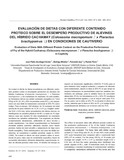Mostrar el registro sencillo del ítem
Evaluación de dietas con diferente contenido proteico sobre el desempeño productivo de alevines del híbrido cachamay (Colossoma macropomum x Piaractus brachypomus) en condiciones de cautiverio
| dc.rights.license | http://creativecommons.org/licenses/by-nc-sa/3.0/ve/ | |
| dc.contributor.author | Uzcátegui Varela, Juan Pablo | |
| dc.contributor.author | Méndez, Xiulingy | |
| dc.contributor.author | Isea, Fernando | |
| dc.contributor.author | Parra, Ramón | |
| dc.date.accessioned | 2014-10-31T21:05:16Z | |
| dc.date.available | 2014-10-31T21:05:16Z | |
| dc.date.issued | 2014-10-31T21:05:16Z | |
| dc.identifier.issn | 0798-2259 | |
| dc.identifier.uri | http://www.saber.ula.ve/handle/123456789/39229 | |
| dc.description.abstract | Se evaluó el efecto de dietas isocalóricas con diferente contenido proteico sobre el desempeño productivo de alevines del híbrido Cachamay (Colossoma macropomum x Piaractus brachypomus ) en condiciones de cautiverio. En este sentido, se formularon dietas con similar contenido energético (2,7 kcal ED/g) al 20; 22; 24 y 26% de proteína cruda (PC), y se compararon con una dieta de balanceado comercial al 28% PC como testigo. Para el ensayo, 200 alevines de 16 semanas de edad (promedio de peso húmedo de 14,76 ± 2,51 g y longitud estándar 8,52 ± 0,02 cm), todos provenientes del mismo desove, se distribuyeron en acuarios plásticos de 68 L a razón de 10 organismos cada uno durante 63 días manteniendo en constante monitoreo las variables ambientales. Fue empleado un diseño completamente aleatorizado, unifactorial de cinco niveles y cuatro repeticiones. Las dietas experimentales se formularon mediante análisis numérico utilizando caseína como fuente proteica, harina de maíz amarillo y subproducto de trigo como fuente energética. Cada materia prima, así como las dietas terminadas, se sometieron a análisis proximal, según la AOAC (1990). Se evaluó el efecto del nivel proteico sobre el incremento de peso, talla, tasa de crecimiento específica, factor de conversión alimenticia, eficiencia alimenticia, supervivencia, índice de eficacia proteica entre otros. Al término del ensayo se reportó un incremento significativo (ANOVA P<0,05) para el peso húmedo total, longitud estándar y consumo de alimento entre tratamientos, siendo la dieta al 26% PC la que arrojó los mejores indicadores de productividad sobre las variables zootécnicas; sin embargo, para la variable factor de conversión alimenticia (FCA), los tratamientos al 20 y 22% PC resultaron ser estadísticamente iguales y con el mayor valor para FCA. Por su parte, con la dieta al 24% PC se alcanzó el efecto promedio, mientras que la dieta al 26% de PC y el testigo fueron estadísticamente similares con el menor valor de FCA. | es_VE |
| dc.language.iso | es | es_VE |
| dc.rights | info:eu-repo/semantics/openAccess | |
| dc.subject | Acuicultura | es_VE |
| dc.subject | Alevín | es_VE |
| dc.subject | Nutrición piscícola | es_VE |
| dc.subject | Peces tropicales | es_VE |
| dc.subject | Proteína dietaria | es_VE |
| dc.title | Evaluación de dietas con diferente contenido proteico sobre el desempeño productivo de alevines del híbrido cachamay (Colossoma macropomum x Piaractus brachypomus) en condiciones de cautiverio | es_VE |
| dc.title.alternative | Evaluation of diets with different protein content on the productive performance of fry of the hybrid cachamay (Colossoma macropomum x Piaractus brachypomus) in captivity | es_VE |
| dc.type | info:eu-repo/semantics/article | |
| dc.description.abstract1 | The effect of isocaloric diets with different protein content on the productive performance of fry of the hybrid Cachamay (Colossoma macropomum x Piaractus brachypomus ) in captivity was evaluated. For these diets with similar energy content (2.7 kcal ED/g) and 20, 22, 24 and 26% crude protein (CP) were formulated and compared with a commercial feed (28% CP as control). For the assay 200 fry of 16 weeks (old average wet weight 14.76 ± 2.51 g standard length 8.52 ± 0.02 cm), all from the same spawning were distributed into plastic aquaria of 68 L, with 10 individuals each, for 63 days maintaining a constant monitoring of environmental variables. A completely randomized unifactorial of five levels and four replicates was employed. The experimental diets were formulated by numerical analysis, using casein as a protein source, and yellow corn and wheat flour energy sources. Proximal analysis of each raw material and the finished feed were performed according to AOAC (1990). The effect of protein level on weight gain, length, specific growth rate, feed conversion, feed efficiency, survival, protein efficiency ratio among others, were analyze dat the end of the study (ANOVA P<0.05) were found for total wet weight, standard length and feed intake between treatments with the 26% CP diet providing the best productivity indicators on zootechnical variables. However, for variable feed conversion (FC), treatments at 20 and 22% CP were statistically similar and provided the best FC values. The diet at 24% CP resulted in an average effect, while the diet at 26% CP and the control were statistically similar with and slowed the lowest FC value. | es_VE |
| dc.description.colacion | 458 - 465 | es_VE |
| dc.description.email | uzcateguij@unesur.edu.ve | es_VE |
| dc.identifier.depositolegal | 199102ZU46 | |
| dc.publisher.pais | Venezuela | es_VE |
| dc.subject.institucion | Universidad del Zulia (LUZ) | es_VE |
| dc.subject.institucion | Universidad de Los Andes (ULA) | es_VE |
| dc.subject.keywords | Aquaculture | es_VE |
| dc.subject.keywords | Fry | es_VE |
| dc.subject.keywords | Fish nutrition | es_VE |
| dc.subject.keywords | Tropical fish | es_VE |
| dc.subject.keywords | Dietary protein | es_VE |
| dc.subject.publicacionelectronica | Revista Científica | |
| dc.subject.seccion | Revista Científica: Vida Silvestre | es_VE |
| dc.subject.thematiccategory | Medio Ambiente | es_VE |
| dc.subject.tipo | Revistas | es_VE |
| dc.type.media | Texto | es_VE |
Ficheros en el ítem
Este ítem aparece en la(s) siguiente(s) colección(ones)
-
Revista Científica - 2014 - Vol. XXIV - No. 005
Septiembre - Octubre 2014


